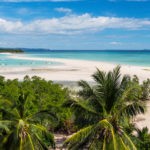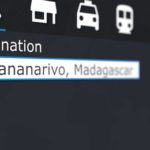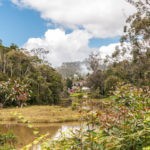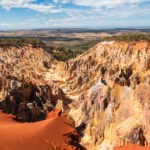The island of Sainte Marie, which lies just off the northeastern coast of Madagascar, the fourth largest island in the world, looks like a small splinter separated from the mainland’s huge neighbor with a surface of 200 km² and a length of about 50 km. While their Malagasy name Nosy Boraha refers to a former Arab settlement, the island was populated in the 16th century by the natives of Madagascar and by Portuguese sailors named “Santa Maria”. Towards the end of the 17th century, the first pirates discovered the island as an ideal hiding place for their predatory trips on the Indian Ocean, which were mainly the cargo ships loaded with colonial goods. At times, up to 1,500 pirates lived on the island in harmony with the local population, led by famous buccaneers. Many of its tombs can still be discovered today on a famous pirate cemetery located on a small island off the island. Here visitors are received by the skulls carved into the gravestones. And even the wreck of many a pirate ship is still in shallow depths in the bay of Ambodifotatra. In the middle of the 18th century, the first Frenchmen entered the island of Sainte Marie, which they took possession of as their colony a hundred years later. In 1897, the small island became part of Madagascar again.
Bathing paradise off the coast of Madagascar
Today, the island of Sainte Marie is next to the the northwest coast of Madagascar located island Nosy Be as one of the most popular resorts of the island nation. However, Saint Marie falls more to the role of a natural paradise that has been spared by mass tourism. Its fascinating flora and fauna, the small picturesque bays, almost untouched sandy beaches and the clear turquoise waters of the ocean, which shine from turquoise to the deep azure, make for a wonderful holiday idyll. They delight nature lovers and peace-seeking vacationers as well as friends of diving, snorkeling or other water sports.
Sainte Marie is conveniently reached by air from Madagascar’s capital Antananarivo or from Toamasina. After a short flight hour, the regular aircraft land at the small airport on the southern tip of Sainte Marie. Less recommendable are ferry crossings, which depend heavily on the weather and partly on ferries with safety deficiencies.
The main town of the island is located on the southwest coast Ambodifotatra. The place offers the complete infrastructure necessary for a stay on the island, which guarantees a smooth holiday. A fact that unfortunately does not apply to the holiday island Nosy Be to the full extent. In addition to the numerous hotels and restaurants in the resort, numerous other, partly luxurious Hotel with pools and lodges along the coast line up to the southern tip of Sainte Marie. Otherwise, there are some smaller places on the coast of the island such as Ambodiatafa and scattered individual lodges and hotels. Almost without exception, they have golden sandy beaches that invite you to swim, dive and snorkel. In addition to the shipwrecks already mentioned, several coral reefs offer enchanting views. Their exploration is particularly safe in the shark-sheltered lagoon of Sainte Marie.
Sainte Marie offers impressive nature experiences
In order to be able to discover the tropical nature of the island individually, Ambodifotatra and most of the scattered hotels offer the possibility to rent a quad, a scooter or even a bicycle. Lonely trails lead through tropical mangrove forests and small waterfalls or ponds. There are many exotic animals and plants to discover. Lonely bays invite you to linger in total peace.
Between July and August, boat trips to observe humpback whales migrating in large groups in front of the island provide a very special attraction. Many of the impressive giants are accompanied by their young, which they raise in the waters off the east coast of Madagascar. An additional experience promises such a ride when the boat is equipped with a hydrophone, with the help of the mysterious song of the whales which is audible.





